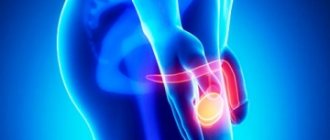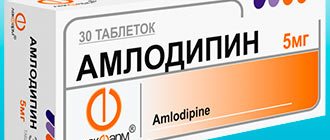Compound
| Film-coated tablets | 1 table |
| active substance: | |
| losartan potassium | 50 mg |
| hydrochlorothiazide | 12.5 mg |
| Excipients | |
| core: mannitol - 89 mg; MCC - 210 mg; croscarmellose sodium - 18 mg; povidone - 7 mg; magnesium stearate – 3.5 mg | |
| film shell: hypromellose 2910/5 - 6.8597 mg; macrogol 6000 - 0.8 mg; talc - 1.9 mg; simethicone emulsion - 0.3 mg; titanium dioxide - 0.1288 mg; quinoline yellow dye (E104) (Quinolin Yellow) - 0.011 mg; crimson dye (E124) (Pounceau 4R) - 0.0005 mg |
Pharmacodynamics
The combined drug has a hypotensive effect. Contains losartan potassium - a blocker (antagonist) of angiotensin II receptors (AT1 subtype) (ARB) and hydrochlorothiazide - a thiazide diuretic.
Losartan/hydrochlorothiazide
Losartan and hydrochlorothiazide demonstrate a synergistic hypotensive effect, reducing blood pressure to a greater extent than either component alone. It is assumed that this effect is the result of the additive action of both components. In addition, as a result of the diuretic effect, hydrochlorothiazide increases plasma renin activity, aldosterone secretion, reduces the concentration of potassium in the blood plasma and increases the content of angiotensin II. The use of losartan blocks all physiologically significant actions of angiotensin II and reduces potassium losses associated with diuretic use through inhibition of aldosterone.
Losartan has a mild and short-term uricosuric effect.
Hydrochlorothiazide leads to a moderate increase in plasma uric acid; the combination of losartan and hydrochlorothiazide helps to attenuate diuretic-induced hyperuricemia.
The hypotensive effect of losartan/hydrochlorothiazide persists for 24 hours. Despite a significant decrease in blood pressure, taking losartan/hydrochlorothiazide does not have a significant clinical effect on heart rate. In clinical studies, it was shown that after 12 weeks of therapy with losartan 50 mg/hydrochlorothiazide 12.5 mg, trough dBP (measured in the sitting position) decreased by an average of 13.2 mmHg. Art. Losartan/hydrochlorothiazide effectively reduces blood pressure in men and women, patients of black and other races, in young (<65 years) and elderly (≥65 years) patients and in any degree of arterial hypertension.
Losartan
It is a synthetic angiotensin II receptor blocker (AT1 type). Angiotensin II, a powerful vasoconstrictor, is the main active hormone of the RAAS and the most important factor in the pathophysiology of arterial hypertension. Angiotensin II binds to AT1 receptors found in many tissues (vascular smooth muscle, adrenal glands, kidneys and heart) and causes a number of biologically important effects, including vasoconstriction and aldosterone release. Angiotensin II also stimulates the proliferation of smooth muscle cells. Losartan selectively blocks AT1 receptors. Losartan and its pharmacologically active carboxyl metabolite E-3174 block all physiologically significant effects of angiotensin II in vitro and in vivo, regardless of the source and route of synthesis of the latter. Losartan does not have an agonistic effect and does not block other hormone receptors or ion channels that play an important role in the regulation of cardiovascular function. In addition, losartan does not inhibit ACE (kininase II), an enzyme that breaks down bradykinin. Therefore, there is no potentiation of undesirable effects mediated by bradykinin.
When using losartan, elimination of the negative feedback reaction of angiotensin II on renin secretion leads to an increase in the activity of the latter in the blood plasma. An increase in renin activity leads to an increase in the concentration of angiotensin II in the blood plasma. Despite this increase, hypotensive activity and a decrease in plasma aldosterone concentrations persist, indicating effective blockade of angiotensin II receptors. After stopping the use of losartan, plasma renin activity and angiotensin II levels return to baseline values within 3 days.
Both losartan and its main active metabolite have a greater affinity for AT1 receptors than for AT2 receptors. This metabolite is 10–40 times more active than losartan.
The incidence of cough is comparable in patients taking losartan or hydrochlorothiazide, and is significantly lower than when using an ACE inhibitor. In patients with arterial hypertension, proteinuria without diabetes mellitus and taking losartan, there was a significant decrease in proteinuria, fractional release of proteins and IgG. Losartan stabilizes the glomerular filtration rate and reduces the filtration fraction. In general, losartan causes a decrease in serum uric acid levels that persists during long-term therapy.
Losartan does not affect autonomic reflexes and does not have a long-term effect on the level of norepinephrine in the blood plasma. In patients with left ventricular failure, 25 and 50 mg of losartan have positive hemodynamic and neurohumoral effects, characterized by an increase in cardiac index and a decrease in pulmonary capillary wedge pressure, systemic vascular resistance, mean systemic blood pressure and heart rate, as well as plasma aldosterone and norepinephrine concentrations, respectively. The development of hypotension in these patients with heart failure was dose-dependent.
Hydrochlorothiazide is a thiazide diuretic. The mechanism of the antihypertensive effect of this group of drugs is not fully known. Thiazide diuretics affect the renal tubular reabsorption mechanisms of electrolytes, directly increasing the excretion of sodium and chloride in approximately equivalent amounts.
The diuretic effect of hydrochlorothiazide reduces plasma volume, increases plasma renin activity and increases aldosterone secretion with a subsequent increase in urinary potassium concentrations and bicarbonate loss and a decrease in plasma potassium concentrations. The coupling of renin to aldosterone is mediated by angiotensin II, and therefore concomitant use of an ARB generally reverses the potassium loss caused by thiazide diuretics.
When taken orally, the diuretic effect of hydrochlorothiazide begins after 2 hours, reaches a maximum after an average of 4 hours, lasts from 6 to 12 hours, and persists for 24 hours.
Pharmacokinetics
Suction
Losartan. It is well absorbed after oral administration and undergoes first-pass metabolism to form an active carboxylic acid metabolite, as well as other inactive metabolites. The systemic bioavailability of losartan in tablet form is approximately 33%. The average Cmax of losartan and its active metabolite is reached after 1 and 3–4 hours, respectively. When losartan was administered concomitantly with a standardized meal, no clinically significant effect on the drug plasma concentration profile was observed.
Hydrochlorothiazide. Rapidly absorbed from the gastrointestinal tract.
Distribution
Losartan. Both losartan and its active metabolite are more than 99% bound to plasma proteins, mainly albumin. Vd of losartan is 34 l. Studies have shown that losartan penetrates poorly or does not penetrate the BBB.
Hydrochlorothiazide. Penetrates the placental barrier, but does not penetrate the BBB and is not excreted into breast milk.
Metabolism
Losartan. About 14% of a dose of losartan administered intravenously or orally is converted into its active metabolite. After intravenous or oral administration of 14C-labeled potassium losartan, radioactivity in circulating blood plasma is mainly due to losartan and its active metabolite. Minimal conversion of losartan to its active metabolite was observed in approximately 1% of study participants. In addition to the active metabolite, inactive metabolites are formed, including 2 major ones, which are formed by hydroxylation of the butyl side chain, and a minor one, N-2-tetrazole glucuronide.
Removal
Losartan. Plasma clearance of losartan and its active metabolite is approximately 600 and 50 ml/min, respectively. The renal clearance of losartan and its active metabolite is approximately 74 and 26 ml/min, respectively. When administered orally, about 4% of the dose of losartan is excreted unchanged in the urine and about 6% of the dose is excreted in the urine as the active metabolite.
The pharmacokinetics of losartan and its active metabolite are linear when administered orally in doses up to 200 mg/day of losartan.
After oral administration, the concentrations of losartan and its active metabolite in the blood plasma decrease polyexponentially with a final T1/2 of about 2 and 6–9 hours, respectively. When a dose of 100 mg is used once a day, losartan and its active metabolite do not accumulate to a significant extent in the blood plasma.
Losartan and its active metabolite are excreted in bile and urine. In humans, after oral administration of 14C-labeled losartan, approximately 35% of the radioactivity is excreted in the urine and 58% through the intestines.
Hydrochlorothiazide. It is not metabolized and is quickly excreted by the kidneys. About 61% of the drug is excreted unchanged. According to the 24-hour determination of the concentration of hydrochlorothiazide in plasma, its T1/2 is 5.8–14.8 hours.
Pharmacokinetics in special groups of patients
Losartan/hydrochlorothiazide. The concentrations of losartan and its active metabolite in the blood plasma, as well as the absorption of hydrochlorothiazide in elderly patients with arterial hypertension do not differ significantly from the indicators observed in young patients with arterial hypertension.
Losartan. In patients with mild to moderate alcoholic cirrhosis of the liver, when taken orally, the concentrations of losartan and its active metabolite in the blood plasma were, respectively, 5 and 1.7 times higher than in young male volunteers. Losartan and its active metabolite are not excreted during hemodialysis.
Overdose
There is no data on specific treatment for drug overdose. in case of overdose, therapy must be stopped and the patient must be under medical supervision. if the drug has been taken recently, it is necessary to induce vomiting and take measures aimed at eliminating dehydration, electrolyte disturbances, hepatic coma and hypotension. Treatment is symptomatic and supportive.
Losartan. Data on drug overdose in humans are limited. The most likely manifestations of an overdose are hypotension and tachycardia; bradycardia may result from parasympathetic (vagal) stimulation. In case of symptomatic arterial hypotension, maintenance therapy is indicated. Losartan and its active metabolite are not eliminated by hemodialysis.
Hydrochlorothiazide. The most commonly reported symptoms of overdose are due to electrolyte deficiency (hypokalemia, hypochloremia, hyponatremia) and dehydration due to excessive urination. When taking cardiac glycosides simultaneously, hypokalemia can cause an increase in the severity of arrhythmia. Hydrochlorothiazide is eliminated by hemodialysis, but the extent of elimination has not been established.
Contraindications
hypersensitivity to the components of the drug or other drugs that are derivatives of sulfonamides;
treatment-resistant hypokalemia or hypercalcemia;
severe liver dysfunction;
obstructive diseases of the biliary tract;
cholestasis;
refractory hyponatremia;
symptomatic hyperuricemia and/or gout;
severe renal dysfunction (creatinine Cl <30 ml/min);
simultaneous use with aliskiren in patients with diabetes mellitus and patients with renal failure (Cl creatinine <60 ml/min);
anuria;
pregnancy;
lactation period;
age under 18 years (efficacy and safety have not been established).
With caution: bilateral renal artery stenosis or stenosis of the artery of a single kidney; hypovolemic conditions (including diarrhea, vomiting); hyponatremia (increased risk of developing arterial hypotension in patients on a low-salt or salt-free diet); hypochloremic alkalosis; hypomagnesemia; connective tissue diseases (including systemic lupus erythematosus), liver dysfunction or progressive liver disease, diabetes mellitus, bronchial asthma (including a history); complicated allergy history; history of angioedema, simultaneous administration with NSAIDs, incl. COX-2 inhibitors; representatives of the Negroid race; heart failure with concomitant severe renal failure; severe chronic heart failure functional class IV according to the NYHA classification; heart failure with life-threatening arrhythmias; cardiac ischemia; cerebrovascular diseases; hyperkalemia; age over 75 years; condition after kidney transplantation (no experience of use); aortic or mitral stenosis; primary hyperaldosteronism; hypertrophic obstructive cardiomyopathy; acute attack of myopia and angle-closure glaucoma; disturbance of the water-electrolyte balance of the blood, for example due to diarrhea or vomiting (hyponatremia, hypochloremic alkalosis, hypomagnesemia, hypokalemia).
special instructions
It is necessary to prescribe with caution to the following categories of patients:
- with water-electrolyte imbalance (dehydration, hyponatremia, hypochloremic alkalosis, hypomagnesemia, hypokalemia), which can develop with intercurrent diarrhea or vomiting;
- with bilateral renal artery stenosis or stenosis of the artery of a single kidney; diabetes mellitus, hypercalcemia, hyperuricemia and/or gout; with a burdened allergic history and asthma; for systemic connective tissue diseases (including systemic lupus erythematosus); hypovolemia (including due to the use of diuretics in high doses); when administered concomitantly with NSAIDs, including COX-2 inhibitors.
Losartan. Renal dysfunction. There are reports that some patients who took the drug, due to inhibition of the function of the renin-angiotensin system, experienced changes in renal function, including renal failure; these changes may be reversible and disappear after cessation of therapy.
Other drugs that affect the renin-angiotensin system may cause increases in urea and creatinine in the blood of patients with bilateral renal artery stenosis and solitary renal artery stenosis.
Similar effects were noted when taking losartan; these changes in renal function may be reversible and disappear after discontinuation of therapy.
Hydrochlorothiazide. Arterial hypotension and water-electrolyte imbalance. As with all antihypertensive agents, symptomatic hypotension may occur in some patients. Patients should be monitored for clinical signs of fluid and electrolyte imbalance, such as dehydration, hyponatremia, hypochloremic alkalosis, hypomagnesemia, or hypokalemia, which may occur with intercurrent diarrhea or vomiting. In such patients, it is necessary to monitor the level of electrolytes in the blood plasma.
Metabolic and endocrine effects. Thiazide therapy may impair glucose tolerance. In some cases, dose adjustment of hypoglycemic agents, including insulin, may be required.
Thiazides may reduce urinary calcium excretion and cause occasional and mild increases in plasma calcium levels. Severe hypercalcemia may indicate latent hyperparathyroidism. It is necessary to stop taking the thiazide diuretic before testing the functions of the parathyroid glands.
Increased levels of cholesterol and TG in the blood may also be associated with therapy with thiazide diuretics.
In some patients, the use of thiazide diuretics can cause hyperuricemia and/or gout. Because losartan reduces uric acid levels, its combination with hydrochlorothiazide reduces the severity of diuretic-induced hyperuricemia.
Other effects. In patients using thiazide diuretics, hypersensitivity reactions may occur even in the absence of indications of allergies or a history of asthma. There are reports of exacerbation or progression of systemic lupus erythematosus when using thiazide diuretics.
The use of the drug may affect the speed of psychomotor reactions.
Use during pregnancy and breastfeeding
BRA II. The use of angiotensin II blockers during pregnancy is contraindicated. Patients planning pregnancy should switch to alternative antihypertensive therapy options with an established safety profile. If pregnancy is diagnosed during treatment, therapy with Lozap® plus should be stopped immediately and alternative treatment should be started.
It is known that treatment with ARBs during the second and third trimesters leads to fetotoxic effects (decreased renal function, oligohydramnios, delayed ossification of the skull), as well as toxicity to the newborn (renal failure, hypotension, hyperkalemia).
In the case of using the drug Lozap® plus in the second or third trimester of pregnancy, an ultrasound scan of the fetal kidneys and skull is recommended.
Children whose mothers took Lozap® plus during pregnancy should be carefully monitored for the development of arterial hypotension.
Due to the lack of information on the use of Lozap® plus during breastfeeding, the use of the drug during this period is contraindicated. During breastfeeding, preference is given to alternative treatment with drugs with a more studied safety profile.
Hydrochlorothiazide. Experience with the use of hydrochlorothiazide during pregnancy, especially during the first trimester, is limited. Animal studies are insufficient. Hydrochlorothiazide penetrates the placental barrier and is detected in the umbilical cord blood. Based on the pharmacological mechanism of action of hydrochlorothiazide, its use during pregnancy may impair fetoplacental blood flow and lead to fetal and neonatal disorders such as jaundice, electrolyte imbalance and thrombocytopenia.
Hydrochlorothiazide is excreted in breast milk. Thiazides can cause intense diuresis and may inhibit milk production. Therefore, the use of Lozap® plus during breastfeeding is contraindicated.
Note!
Description of the drug Lozap Plus table. p/o No. 90 on this page is a simplified author’s version of the apteka911 website, created on the basis of the instructions for use.
Before purchasing or using the drug, you should consult your doctor and read the manufacturer's original instructions (attached to each package of the drug). Information about the drug is provided for informational purposes only and should not be used as a guide to self-medication. Only a doctor can decide to prescribe the drug, as well as determine the dose and methods of its use.
Side effects
Adverse reactions are distributed according to frequency as follows: very often (≥1/10); often (≥1/100, <1/10); uncommon (≥1/1000, <1/100); rare (≥1/10000, <1/1000); very rare (<1/10000); frequency unknown (cannot be calculated from available data).
In clinical studies with losartan/hydrochlorothiazide, no adverse reactions associated with the drug combination were observed. Adverse reactions are limited to those previously observed with the use of losartan and/or hydrochlorothiazide alone.
In controlled clinical trials for the treatment of essential hypertension in patients receiving losartan and hydrochlorothiazide, the only adverse reaction occurring at an incidence of 1% or more compared with placebo was dizziness. In addition, there are other adverse reactions that have been reported during the use of the losartan/hydrochlorothiazide combination.
Losartan/hydrochlorothiazide
From the nervous system: frequency unknown - dysgeusia.
Vascular: frequency unknown - dose-dependent orthostatic effect.
From the skin and subcutaneous tissues: frequency unknown - cutaneous form of systemic lupus erythematosus.
From the liver and biliary tract: rarely - hepatitis.
Impact on the results of laboratory and instrumental studies: rarely - hyperkalemia, increased activity of liver transaminases.
In addition, when using losartan/hydrochlorothiazide, the following adverse reactions may occur, which were observed with the use of each of the components.
Losartan
From the blood and lymphatic system: infrequently - anemia, Henoch-Schönlein disease, ecchymosis, hemolysis; frequency unknown - thrombocytopenia.
From the immune system: rarely - hypersensitivity reactions (anaphylactic reactions, angioedema, including swelling of the larynx and glottis with the development of airway obstruction and/or swelling of the face, lips, pharynx and/or tongue); Some of these patients had a history of angioedema due to the use of other drugs, including ACE inhibitors.
From the side of metabolism and nutrition: infrequently - anorexia, gout.
Mental disorders: often - insomnia; uncommon - restlessness, anxiety, panic attacks, confusion, depression, unusual dreams, sleep disturbance, drowsiness, memory impairment.
From the nervous system: often - headache, dizziness; uncommon - increased excitability, paresthesia, peripheral neuropathy, tremor, migraine, syncope.
From the side of the organ of vision: infrequently - blurred vision, burning sensation in the eyes, conjunctivitis, decreased visual acuity.
From the organ of hearing and labyrinthine disorders: infrequently - vertigo, ringing in the ears.
From the heart: uncommon - decreased blood pressure, orthostatic hypotension, pain in the sternum, angina pectoris, 2nd degree AV block, myocardial infarction, palpitations, arrhythmias (atrial fibrillation, sinus bradycardia, tachycardia, ventricular tachycardia, ventricular fibrillation).
From the side of blood vessels: infrequently - vasculitis.
From the respiratory system, chest and mediastinal organs: often - cough, upper respiratory tract infections, nasal congestion, sinusitis; uncommon - pharyngitis, laryngitis, dyspnea, bronchitis, nosebleeds, rhinitis.
From the gastrointestinal tract: often - abdominal pain, nausea, diarrhea, dyspepsia; uncommon - constipation, toothache, dry mouth, flatulence, gastritis, vomiting.
From the liver and biliary tract: frequency unknown - impaired liver function.
From the skin and subcutaneous tissues: uncommon - alopecia, dermatitis, dry skin, erythema, hyperemia, photosensitivity, itching, rash, sweating.
From the musculoskeletal and connective tissue side: often - muscle cramps, back pain, leg pain, sciatica; uncommon - joint swelling, muscle and bone pain, joint stiffness, arthralgia, arthritis, fibromyalgia, muscle weakness; frequency unknown - rhabdomyolysis.
From the kidneys and urinary tract: often - impaired renal function, renal failure; uncommon - nocturia, urinary urgency, urinary tract infections.
From the genital organs and breast: infrequently - decreased libido, erectile dysfunction.
General disorders and disorders at the injection site: often - asthenia, fatigue, chest pain; infrequently - swelling of the face, fever; frequency unknown - flu-like symptoms, weakness.
Laboratory and instrumental data: often - hyperkalemia, slight decrease in hematocrit and hemoglobin; infrequently - a slight increase in the level of urea and creatinine in the blood plasma; very rarely - increased activity of liver transaminases and bilirubin; frequency unknown - hyponatremia.
Hydrochlorothiazide
From the blood and lymphatic system: uncommon - agranulocytosis, aplastic anemia, hemolytic anemia, leukopenia, purpura, thrombocytopenia.
From the immune system: rarely - anaphylactic reactions up to shock.
From the side of metabolism and nutrition: infrequently - anorexia, hyperglycemia, hyperuricemia, hypokalemia, hyponatremia.
Mental disorders: infrequently - insomnia.
From the nervous system: often - headache.
From the side of the organ of vision: infrequently - temporary decrease in visual acuity, xanthopsia.
From the side of blood vessels: infrequently - necrotizing vasculitis, cutaneous vasculitis.
From the respiratory system, chest and mediastinal organs: rarely - respiratory distress syndrome, including pneumonitis and non-cardiogenic pulmonary edema.
From the gastrointestinal tract: uncommon - sialadenitis, spasms, gastritis, nausea, vomiting, diarrhea, constipation.
From the liver and biliary tract: infrequently - cholestatic jaundice, cholecystitis, pancreatitis.
From the skin and subcutaneous tissues: infrequently - photosensitivity, urticaria, toxic epidermal necrolysis.
From the musculoskeletal and connective tissue side: infrequently - muscle cramps.
From the kidneys and urinary tract: uncommon - glycosuria, interstitial nephritis, renal dysfunction, renal failure.
General disorders and disorders at the injection site: uncommon - fever, dizziness.
Interaction
Losartan
Cases of decreased concentrations of the active metabolite have been described with the combined use of rifampicin and fluconazole. Clinical evidence for such interactions has not been evaluated.
As with other drugs that block angiotensin II or its effects, concomitant use of potassium-sparing diuretics (eg, spironolactone, triamterene, amiloride), potassium supplements, or potassium-containing salt substitutes may result in increased plasma potassium concentrations. The combined use of these drugs is not recommended.
As with other drugs that affect sodium excretion, the drug may slow down the excretion of lithium. Therefore, when prescribing lithium salts and ARBs simultaneously, it is necessary to carefully monitor the concentration of lithium salts in the blood plasma.
With the simultaneous use of ARBs and NSAIDs, for example, selective COX-2 inhibitors, acetylsalicylic acid in doses used for anti-inflammatory effect, and non-selective NSAIDs, a weakening of the hypotensive effect of Lozap® plus may be observed.
The simultaneous use of ARBs or diuretics and NSAIDs may cause an increased risk of deterioration of renal function, incl. acute renal failure and increased plasma potassium levels, especially in patients with underlying renal impairment. Combination treatment should be prescribed with caution, especially in elderly patients. Patients should be adequately hydrated and renal function monitored after initiation of combination treatment and periodically during treatment. In some patients with impaired renal function receiving treatment with NSAIDs, incl. selective COX-2 inhibitors, concomitant use of ARBs may worsen renal dysfunction. These effects are usually reversible. Dual blockade (for example, adding an ACE inhibitor or aliskiren to an ARB) should be carried out only in selected cases, constantly monitoring blood pressure, renal function and plasma electrolytes. There is evidence that dual blockade of the RAAS in patients with diagnosed atherosclerosis, heart failure or diabetes mellitus with target organ damage is associated with an increased incidence of arterial hypotension, syncope, hyperkalemia and renal dysfunction (including acute renal failure), when compared with the use of one a drug that affects the RAAS.
The use of losartan together with aliskiren is contraindicated in patients with diabetes mellitus or impaired renal function (Cl creatinine <60 ml/min).
The drug Lozap® plus, when used simultaneously with other drugs that cause a decrease in blood pressure, such as tricyclic antidepressants, antipsychotic drugs, baclofen, amifostine, may increase the risk of developing arterial hypotension.
Hydrochlorothiazide
When taken concomitantly with thiazide diuretics, interactions with the following substances may occur.
Alcohol, barbiturates, narcotics or antidepressants. The risk of orthostatic hypotension may increase.
Antidiabetic drugs (insulin and oral drugs). Treatment with thiazide diuretics may affect glucose tolerance. Dosage adjustment of antidiabetic drugs may be required. Metformin should be used with caution due to the risk of lactic acidosis caused by possible functional renal failure associated with the use of hydrochlorothiazide.
Other antihypertensive drugs. Additive effect.
Cholestyramine and colestipol. In the presence of ion exchange resins, the absorption of hydrochlorothiazide is impaired. Taking a single dose of cholestyramine or colestipol leads to the binding of hydrochlorothiazide and a decrease in its absorption from the gastrointestinal tract by 85 and 43%, respectively.
Corticosteroids, adrenocorticotropic hormone (ACTH). Possible worsening of electrolyte deficiency, especially hypokalemia.
Pressor amines (for example adrenaline). It is possible that the effect of pressor amines may be reduced, but this does not preclude their use.
Non-depolarizing muscle relaxants (eg tubocurarine chloride). The effect of muscle relaxants may be enhanced.
Lithium preparations. Diuretics reduce the renal clearance of lithium and significantly increase the risk of lithium toxicity. It is recommended to avoid the simultaneous use of hydrochlorothiazide with lithium preparations.
Medicines used to treat gout (probenecid, sulfinpyrazone and allopurinol). Dosage adjustment of anti-gout medications may be required since hydrochlorothiazide can increase plasma uric acid concentrations. Concomitant use with thiazides may increase the incidence of hypersensitivity reactions to allopurinol.
Anticholinergic drugs (eg atropine, biperidine). It is possible to increase the bioavailability of thiazide diuretics by reducing gastrointestinal motility and the rate of gastric emptying.
Cytotoxic drugs (eg cyclophosphamide, methotrexate). Thiazide diuretics can inhibit the renal excretion of cytotoxic drugs and enhance their myelosuppressive effect.
Salicylates. When using high doses of salicylates, hydrochlorothiazide may enhance their toxic effects on the central nervous system.
Methyldopa. Isolated cases of the development of hemolytic anemia have been described in patients simultaneously receiving hydrochlorothiazide and methyldopa.
Cyclosporine. Concomitant treatment with cyclosporine may increase the risk of hyperuricemia and complications of gout.
Cardiac glycosides. Hypokalemia or hypomagnesemia caused by thiazide diuretics may contribute to the development of digitalis-induced arrhythmias.
Medicines whose effect is influenced by changes in the concentration of potassium in the blood plasma. When prescribing Lozap® plus simultaneously with drugs whose effect is affected by changes in the potassium content in the blood plasma (for example, digitalis glycosides and antiarrhythmic drugs), it is recommended to regularly monitor the concentration of potassium in the blood plasma and ECG monitoring. These measures are also recommended when using the drug Lozap® plus simultaneously with the following drugs that can cause torsade de pointes (ventricular tachycardia) (including antiarrhythmics), since hypokalemia is a factor predisposing to the development of torsade de pointes: class 1A antiarrhythmic drugs (for example quinidine, hydroquinidine, disopyramide); class III antiarrhythmics (eg amiodarone, sotalol, dofetilide, ibutilide); some antipsychotic drugs (eg thioridazine, chlorpromazine, levomepromazine, trifluoperazine, cyamemazine, sulpiride, sultopride, amisulpride, tiapride, pimozide, haloperidol, droperidol); others (eg bepridil, cisapride, difemanil, erythromycin IV, halofantrine, mizolastine, pentamidine, terfenadine, vincamycin IV).
Calcium salts. Thiazide diuretics may increase plasma calcium levels by decreasing calcium excretion. If the patient is taking calcium supplements, it is necessary to monitor the calcium level in the blood plasma and adjust the dosage of calcium supplements accordingly.
Influence on laboratory test results. Due to their effect on calcium metabolism, thiazides may interfere with test results to assess parathyroid function.
Carbamazepine. There is a risk of developing symptomatic hyponatremia. Clinical observation and laboratory monitoring of blood sodium levels are necessary in patients taking carbamazepine.
Iodinated contrast agents. In case of dehydration caused by the use of diuretics, the risk of developing acute renal failure increases, especially when taking high doses of iodine preparations. Patients should be rehydrated before administration.
Amphotericin B (parenteral), corticosteroids, ACTH, stimulant laxatives, or glycyrrhizin (found in licorice). Hydrochlorothiazide may cause electrolyte deficiency, especially hypokalemia.
Lozap® Plus
Hydrochlorothiazide
Renal dysfunction
In patients with impaired renal function, hydrochlorothiazide may cause azotemia. In case of renal failure, accumulation of hydrochlorothiazide is possible.
In patients with reduced renal function, periodic monitoring of creatinine clearance is necessary. If renal dysfunction progresses and/or oliguria (anuria) occurs, hydrochlorothiazide should be discontinued.
Liver dysfunction
When using thiazide diuretics in patients with impaired liver function, hepatic encephalopathy may develop. In patients with severe liver failure or hepatic encephalopathy, the use of thiazides is contraindicated. In patients with mild to moderate hepatic impairment and/or progressive liver disease, hydrochlorothiazide should be used with caution, since even slight changes in fluid electrolyte balance and ammonium accumulation in the blood serum can cause hepatic coma. If symptoms of encephalopathy occur, diuretics should be discontinued immediately.
Water-electrolyte balance and metabolic disorders
Thiazide diuretics (including hydrochlorothiazide) can cause a decrease in the volume of circulating fluid (hypovolemia) and disturbances in water and electrolyte balance (including hypokalemia, hyponatremia, hypochloremic alkalosis). Clinical symptoms of fluid and electrolyte imbalance include dry mouth, thirst, weakness, lethargy, fatigue, drowsiness, restlessness, muscle pain or cramps, muscle weakness, marked decrease in blood pressure, oliguria, tachycardia, arrhythmia and gastrointestinal disorders (such as nausea and vomiting). In patients receiving hydrochlorothiazide therapy (especially with long-term course treatment), clinical symptoms of water-electrolyte imbalance should be identified and blood electrolyte levels should be regularly monitored.
Sodium
All diuretics can cause hyponatremia, sometimes leading to severe complications. Hyponatremia and hypovolemia can lead to dehydration and orthostatic hypotension. A concomitant decrease in chlorine ions can lead to secondary compensatory metabolic alkalosis, but the frequency and severity of this effect are insignificant. It is recommended to determine the content of sodium ions in the blood plasma before starting treatment and regularly monitor this indicator while taking hydrochlorothiazide.
Potassium
When using thiazide and thiazide-like diuretics, there is a risk of a sharp decrease in the potassium content in the blood plasma and the development of hypokalemia (potassium concentration less than 3.4 mmol/l). Hypokalemia increases the risk of developing heart rhythm disturbances (including severe arrhythmias) and enhances the toxic effect of cardiac glycosides. In addition, hypokalemia (as well as bradycardia) is a condition that contributes to the development of polymorphic ventricular tachycardia of the “pirouette” type, which can be fatal.
Hypokalemia poses the greatest danger to the following groups of patients: elderly people, patients simultaneously receiving therapy with antiarrhythmic and non-antiarrhythmic drugs that can cause polymorphic ventricular tachycardia of the "pirouette" type or increase the duration of the QT interval on the ECG, patients with impaired liver function, coronary heart disease , chronic heart failure. In addition, patients with an increased QT interval are at increased risk. It does not matter whether this increase is caused by congenital causes or the effect of drugs.
In all the cases described above, it is necessary to avoid the risk of developing hypokalemia and regularly monitor the potassium content in the blood plasma. The first measurement of the content of potassium ions in the blood must be carried out within the first week from the start of treatment. If hypokalemia occurs, appropriate treatment should be prescribed. Hypokalemia can be corrected by using potassium-containing medications or eating foods rich in potassium (dried fruits, fruits, vegetables).
Calcium
Thiazide diuretics may reduce the excretion of calcium ions by the kidneys, leading to a slight and temporary increase in plasma calcium levels. In some patients, with long-term use of thiazide diuretics, pathological changes in the parathyroid glands were observed with hypercalcemia and hyperphosphatemia, but without the typical complications of hyperparathyroidism (nephrolithiasis, decreased bone mineral density, peptic ulcer). Severe hypercalcemia may be a manifestation of previously undiagnosed hyperparathyroidism.
Because of their effect on calcium metabolism, thiazides may interfere with laboratory parameters of parathyroid function. Thiazide diuretics (including hydrochlorothiazide) should be discontinued before testing parathyroid function.
Magnesium
Thiazides have been found to increase renal excretion of magnesium, which can lead to hypomagnesemia. The clinical significance of hypomagnesemia remains unclear.
Glucose
Treatment with thiazide diuretics may impair glucose tolerance. When using hydrochlorothiazide in patients with manifest or latent diabetes mellitus, it is necessary to regularly monitor the concentration of glucose in the blood. Dosage adjustment of hypoglycemic medications may be required.
Uric acid
In patients with gout, the frequency of attacks may increase or the course of gout may worsen. Careful monitoring of patients with gout and impaired uric acid metabolism (hyperuricemia) is necessary.
Lipids
When using hydrochlorothiazide, the concentration of cholesterol and triglycerides in the blood plasma may increase.
Acute myopia/secondary angle-closure glaucoma
Hydrochlorothiazide can cause an idiosyncratic reaction, leading to the development of acute myopia and an acute attack of secondary angle-closure glaucoma. Symptoms include: sudden loss of visual acuity or eye pain, usually occurring within hours to weeks of starting hydrochlorothiazide therapy. If left untreated, acute angle-closure glaucoma can lead to irreversible vision loss. If symptoms appear, you should stop taking hydrochlorothiazide as soon as possible. If intraocular pressure remains uncontrolled, emergency medical treatment or surgery may be required. Risk factors for the development of acute angle-closure glaucoma are: a history of an allergic reaction to sulfonamides or penicillin.
Immune system disorders
There are reports that thiazide diuretics (including hydrochlorothiazide) can cause exacerbation or progression of systemic lupus erythematosus, as well as lupus-like reactions.
In patients receiving thiazide diuretics, hypersensitivity reactions may occur even in the absence of a history of allergic reactions or bronchial asthma.
Photosensitivity
Cases of photosensitivity reactions have been reported when taking thiazide diuretics. If photosensitivity occurs while taking hydrochlorothiazide, treatment should be discontinued.
Non-melanoma skin cancer and lip cancer
Two epidemiological studies based on the Danish National Cancer Registries showed an increased risk of developing non-melanoma skin cancer and lip cancer (basal cell carcinoma of the skin and squamous cell carcinoma of the skin) with increasing cumulative dose of hydrochlorothiazide.
Hydrochlorothiazide has a photosensitizing effect, which may cause the development of non-melanoma skin and lip cancer.
Patients taking hydrochlorothiazide should be informed of the risk of developing non-melanoma skin and lip cancer and the need to regularly examine the skin for new changes as well as changes in existing ones. If any suspicious skin lesions are detected, the patient should immediately consult a doctor. Particular attention should be paid to patients who have known risk factors for skin cancer, including: skin phototypes II (pale and fair skin), a family history of skin cancer, a history of skin damage caused by sun or ultraviolet radiation and radiation therapy , smoking and taking drugs with photosensitizing effects.
Patients should be advised to take measures to prevent the development of skin cancer, such as limiting time in the sun and exposure to ultraviolet rays, and using appropriate sunscreens when exposed to the sun. Any suspicious skin lesions should be immediately examined, including histological examination of material obtained by biopsy of tissue at the site of the lesion. It may also be necessary to reconsider the use of hydrochlorothiazide in patients with a history of non-melanoma skin cancer and lip cancer.
Athletes
Hydrochlorothiazide may give a positive result during doping control in athletes.
Other
In patients with severe atherosclerosis of the cerebral and coronary arteries, hydrochlorothiazide should be used with extreme caution.
Thiazide diuretics can reduce the amount of iodine bound to plasma proteins without causing signs of thyroid dysfunction.
Evidence from epidemiological studies
Two epidemiological studies based on the Danish National Cancer Registries revealed a relationship between hydrochlorothiazide use and the risk of developing non-melanoma skin and lip cancer (basal cell carcinoma and squamous cell carcinoma). In one study, high-dose hydrochlorothiazide (cumulative dose >50,000 mg) was associated with the development of basal cell carcinoma and squamous cell carcinoma. Another study observed a possible association between the risk of lip cancer and hydrochlorothiazide use. There was a clear relationship between cumulative dose and response for patients who received at least one dose, for patients who received the highest dose (>25,000 mg), and for patients who received the highest cumulative dose (>100,000 mg).
Losartan
Angioedema
Patients with a history of angioedema (including swelling of the larynx and vocal folds with the development of airway obstruction and/or swelling of the face, lips, pharynx and/or tongue) require careful monitoring of the use of the drug.
Arterial hypotension and decreased circulating blood volume (CBV)
In patients with hypovolemia and/or reduced sodium levels in the blood plasma resulting from intensive use of diuretics, restriction of dietary salt intake, diarrhea or vomiting, symptomatic arterial hypotension may develop (especially after taking the first dose). It is necessary to correct such conditions before starting the use of losartan.
Water-electrolyte imbalance
Fluid and electrolyte imbalances often occur in patients with impaired renal function (with or without diabetes mellitus), therefore the concentration of potassium in the blood plasma and creatinine clearance should be carefully monitored, especially in patients with heart failure and creatinine clearance in the range of 30-50 ml /min. The simultaneous use of losartan with potassium-sparing diuretics, potassium supplements and potassium-containing salt substitutes is not recommended.
Liver dysfunction
Pharmacokinetic data indicate a marked increase in plasma concentrations of losartan in patients with cirrhosis; losartan should be used with caution in patients with a history of mild or moderate hepatic impairment (<9 Child-Pugh points). There is no experience with the use of losartan in patients with severe liver dysfunction, therefore the use of losartan is contraindicated in this group of patients.
Renal dysfunction
Impaired renal function has been reported due to inhibition of the RAAS, including renal failure (particularly in patients whose renal function is dependent on the RAAS, for example, with severe heart failure or existing renal impairment). As with the use of other drugs that affect the RAAS, cases of increased concentrations of urea and creatinine in the blood plasma have been described in patients with bilateral renal artery stenosis or with renal artery stenosis of a single kidney. These changes in renal function may be reversible and decrease after treatment is discontinued. Losartan should be used with caution in patients with bilateral renal artery stenosis or renal artery stenosis of a solitary kidney.
Kidney transplant
There is no experience with the use of losartan in patients who have recently undergone kidney transplantation, so caution should be exercised when using the drug in such patients.
Primary hyperaldosteronism
Patients with primary hyperaldosteronism typically do not respond to treatment with antihypertensive drugs that inhibit the RAAS. For this reason, the use of losartan is not recommended.
Coronary heart disease and cerebrovascular disease
As with the use of any other antihypertensive drugs, an excessive decrease in blood pressure in patients with coronary heart disease or cerebrovascular disease can lead to the development of myocardial infarction or ischemic stroke.
Heart failure
As with other drugs that affect the RAAS, patients with heart failure with or without renal impairment are at risk of developing severe hypotension and acute renal failure.
Aortic and mitral valve stenosis, hypertrophic obstructive cardiomyopathy
As with other vasodilators, special caution should be exercised in patients with aortic or mitral stenosis or hypertrophic obstructive cardiomyopathy.
Differences due to ethnicity
By analogy with other ACE inhibitors, losartan and other ARBs are markedly less effective in lowering blood pressure in blacks compared to patients of other races. This may be due to more frequent cases of low renin concentrations in representatives of the Negroid race with hypertension.
Dual blockade of the renin-angiotensin-aldosterone system
There is evidence that the simultaneous use of ACE inhibitors, ARB II or aliskiren increases the risk of arterial hypotension, hyperkalemia and renal dysfunction (including acute renal failure), therefore, double blockade of the RAAS when using a combination of losartan with ACE inhibitors or aliskiren is not recommended. If it is necessary to carry out double blockade of the RAAS, treatment should be carried out under the supervision of a specialist with frequent and careful monitoring of renal function, water and electrolyte balance and blood pressure indicators.
Concomitant use of ARB II, including losartan, with drugs containing aliskiren is contraindicated in patients with diabetes mellitus and/or patients with moderate to severe renal impairment (GFR less than 60 ml/min/1.73 m2 body surface area) and is not recommended in other patients (see section “Contraindications”),
Concomitant use of ARB II, including losartan, with ACE inhibitors is contraindicated in patients with diabetic nephropathy and is not recommended in other patients (see section "Contraindications").
Excipient
The drug contains Crimson dye [Ponceau 4R], which can cause allergic reactions.
Directions for use and doses
Inside, regardless of food intake.
Arterial hypertension. The usual initial and maintenance dose is 1 tablet. in a day. For those patients in whom it is not possible to achieve adequate blood pressure at this dosage, the dose of the drug can be increased to 2 tablets. 1 per day.
The maximum dose is 2 tablets. 1 per day. In general, the maximum hypotensive effect is achieved within 3 weeks after the start of treatment.
There is no need for special selection of the initial dose in elderly patients.
Reducing the risk of cardiovascular disease and mortality in patients with arterial hypertension and left ventricular hypertrophy. The usual starting dose of losartan is 50 mg once daily. Patients who fail to achieve target blood pressure levels while taking losartan 50 mg/day require selection of therapy by combining losartan with low doses of hydrochlorothiazide (12.5 mg). If necessary, you need to increase the dose of losartan to 100 mg/day in combination with hydrochlorothiazide at a dose of 12.5 mg/day (1 tablet of Lozap® plus 1 time per day), then increase the dose to 2 tablets. drug Lozap® plus (50 + 12.5 mg) (total 100 mg of losartan and 25 mg of hydrochlorothiazide) 1 time per day.






